Parsing Lumoz: Decentralized Computing Infrastructure for the Era of AI, ZK, and RaaS
Key Takeaways
Advantages and Challenges of ZKP: ZKP is a powerful blockchain technology that can address privacy and scalability issues. However, it requires significant computational resources, leading to high computational costs and potential centralization risks.
The Power of Decentralized Modular Computing Layers: To tackle the challenges of ZKP, Lumoz harnesses modular infrastructure to aggregate network computing power, accelerating ZK technology through ZK-RaaS.
AI and TEE are Reshaping Future Innovations: Lumoz enables applications of technologies beyond ZK. By providing high-performance AI computing and using TEE and DROT to protect AI processes, it enhances data security and result verification, driving the integration of Web3 and AI.
1. Introduction
Vitalik Buterin's Defensive Accelerationism (d/acc) philosophy emphasizes two key principles. First, resist the concentration of power by accelerating technological progress; second, advocate for decentralized development. Blockchain technology embodies this idea, as it can decentralize power and prevent centralization.
However, blockchain technology also has its flaws. As the network scales, the operation speed of decentralized systems may slow down, limiting their performance. At the same time, the exponential growth of data storage leads to insufficient scalability. Although on-chain transparency provides traceability, it also diminishes user privacy protection.
Zero-Knowledge Proofs (ZKP) emerge as a new solution to address privacy challenges in blockchain, allowing users to prove the validity of a fact without sharing actual information. For example, a user can prove they are of voting age without revealing their birth date, validating the fact while protecting sensitive information.
When applied in blockchain, zero-knowledge proofs enable the network to verify the validity of transactions without disclosing private information such as transfer amounts or sender identities. This allows users to ensure the system's credibility while protecting their personal information.
ZKP technology addresses two major challenges in blockchain. First, the privacy issue: ZKP can verify the validity of transactions without disclosing details such as amounts or the identities of traders. Second, scalability: blockchain can perform computations externally and use ZKP to verify results, thereby alleviating the computational burden on the network and improving efficiency.
ZKP excels in Layer 2 scaling solutions. Layer 2 processes transactions off-chain and submits the results along with proof of their correct execution to the Ethereum mainnet, significantly enhancing processing speed and scalability while maintaining system integrity. As an important tool for advancing decentralized technology, ZKP effectively addresses privacy and scalability issues.
2. Challenges of ZK Implementation: High Costs and Centralization Risks
The complex cryptographic computations required to generate zero-knowledge proofs demand powerful computing capabilities, similar to the computational needs of Bitcoin mining or training large AI models.

The demand for high-performance computing is particularly pronounced in Layer 2 scaling solutions like ZK-Rollups. For instance, generating ZKP for a batch of 250 ERC-20 transactions on Polygon zkEVM using a server equipped with AMD 224 vCPUs and 896 GB RAM takes about 2 minutes, with an operational cost of approximately $0.32, amounting to $6,909 monthly. In contrast, a regular web server requires only 4 vCPUs and 8 GB RAM.
These high hardware requirements present two major challenges for ZKP technology. First, only a few high-performance machines can generate these proofs, which contradicts the goal of decentralizing control to more users. This dependency makes achieving true decentralization difficult. Second, the limitations of computational resources also affect the scale of proof batches that can be processed, thereby reducing the efficiency and scalability of ZKP technology.
To overcome these challenges, ZKP infrastructure needs to become more efficient and accessible. Reducing technical complexity and lowering entry barriers are key to expanding the ZKP ecosystem. Lumoz addresses these issues through its modular computing infrastructure and decentralized prover network, aiming to resolve the trilemma of decentralization, scalability, and security in blockchain.
3. Lumoz: Illuminating the Path of zk/acc

Lumoz is a modular computing layer for ZK, AI, and RaaS, providing powerful computing capabilities and verification services for cross-chain ZK and AI applications. Network participants share computing power to reduce centralization dependence and achieve true decentralization. Additionally, Lumoz's ZK-RaaS platform lowers the barriers to ZK-Rollups and accelerates the development of ZK technology through zk/acc.
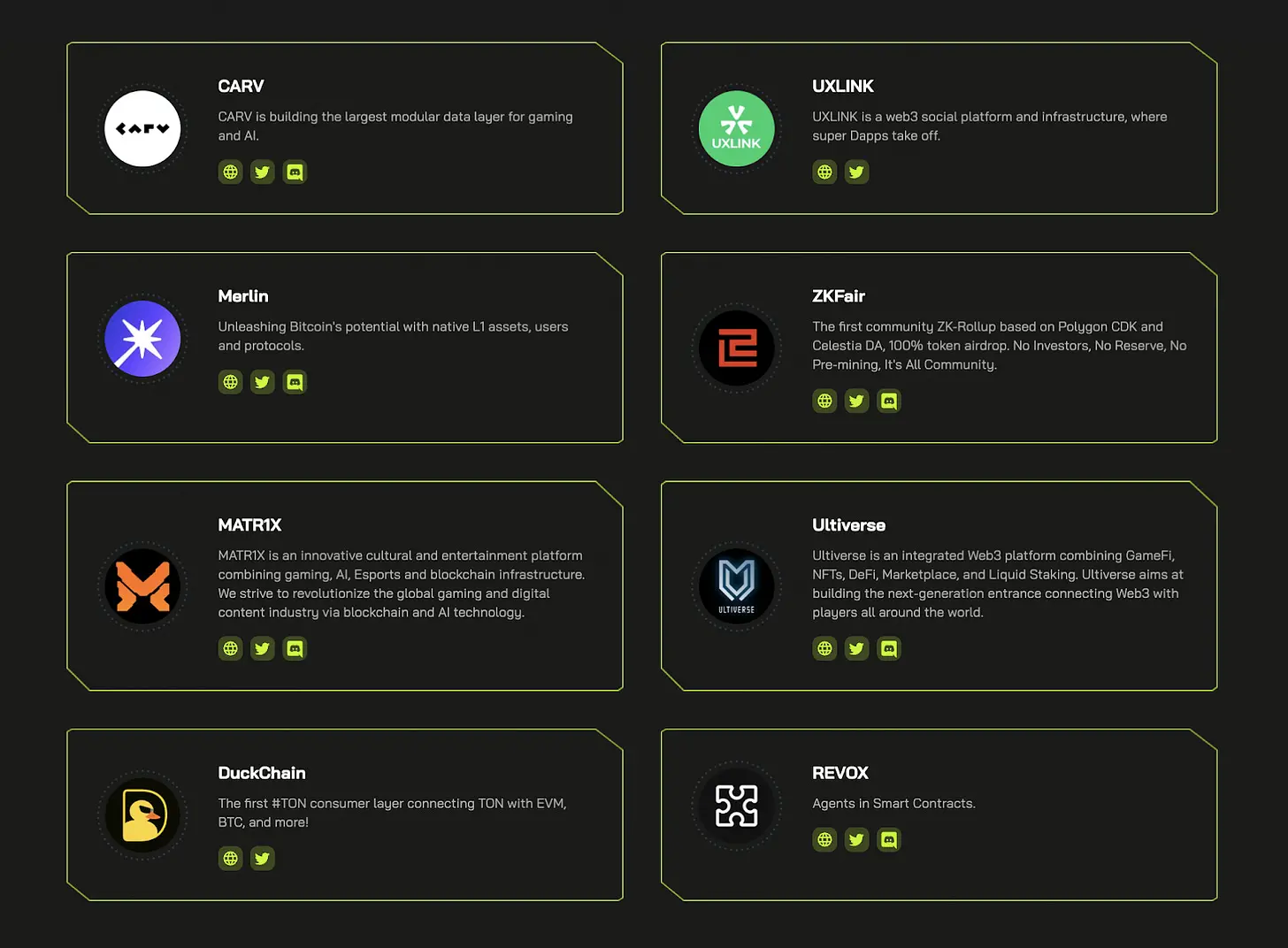
Source: Lumoz
Lumoz's technology has gained market recognition. Over 20 Layer 2 projects, including Carv, Merlin Chain, ZKFair, Ultiverse, Matr1x, and Uxlink, utilize Lumoz infrastructure. In early 2024, Lumoz secured $14 million in funding from well-known investors such as OKX Ventures, Hashkey Capital, Kucoin Ventures, and Polygon.
3.1. Lumoz Chain, the ZK Modular Computing Layer
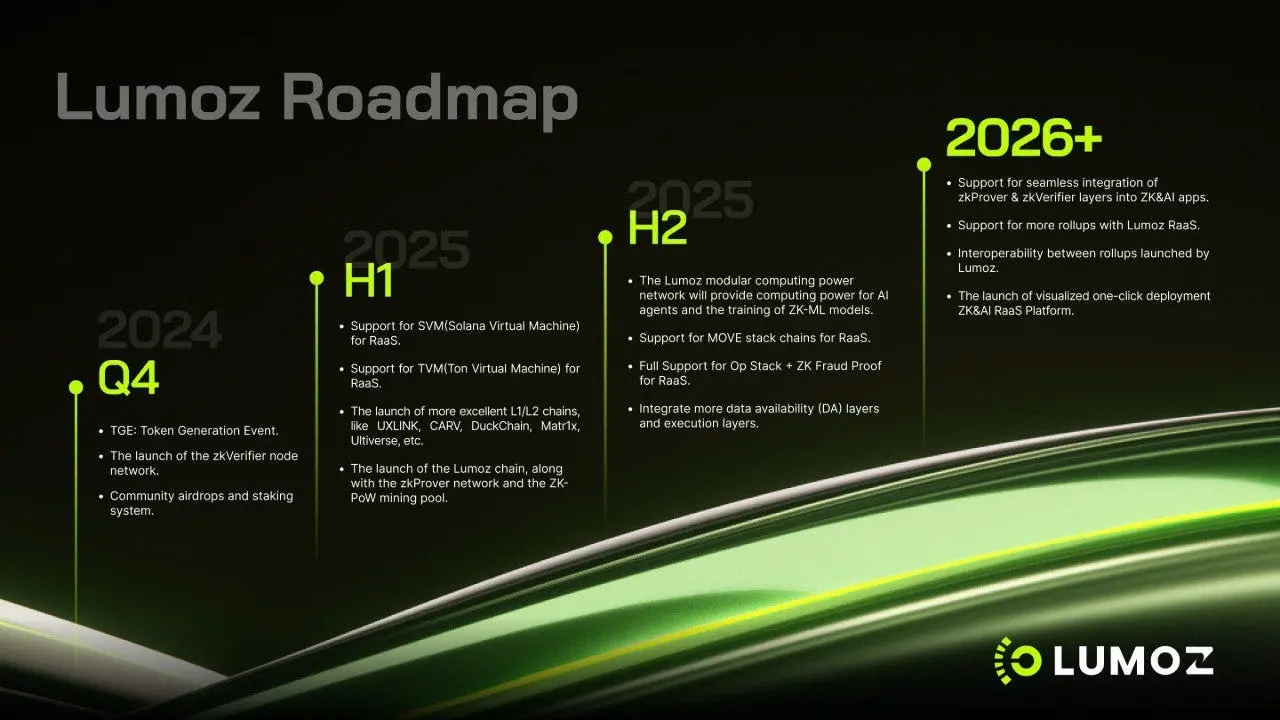
Source: Lumoz
Lumoz Chain is set to launch its mainnet in Q1 2025. It aims to create a decentralized physical infrastructure network (DePIN) for high-performance computing tasks, including ZKP technology. Lumoz provides 1) a modular architecture, 2) a hybrid consensus model, and 3) optimized performance for intensive computations. This will make zero-knowledge proofs more affordable and accessible while helping blockchain networks handle more users without relying on central control.
3.1.1. Modular Architecture
Lumoz adopts a modular design that allows each project to customize its settings. Just like building with blocks - projects can choose and arrange the components they need. Projects can configure their infrastructure based on specific requirements. Each module operates independently, ensuring efficient system configuration. This approach reduces integration complexity and enhances overall system efficiency.
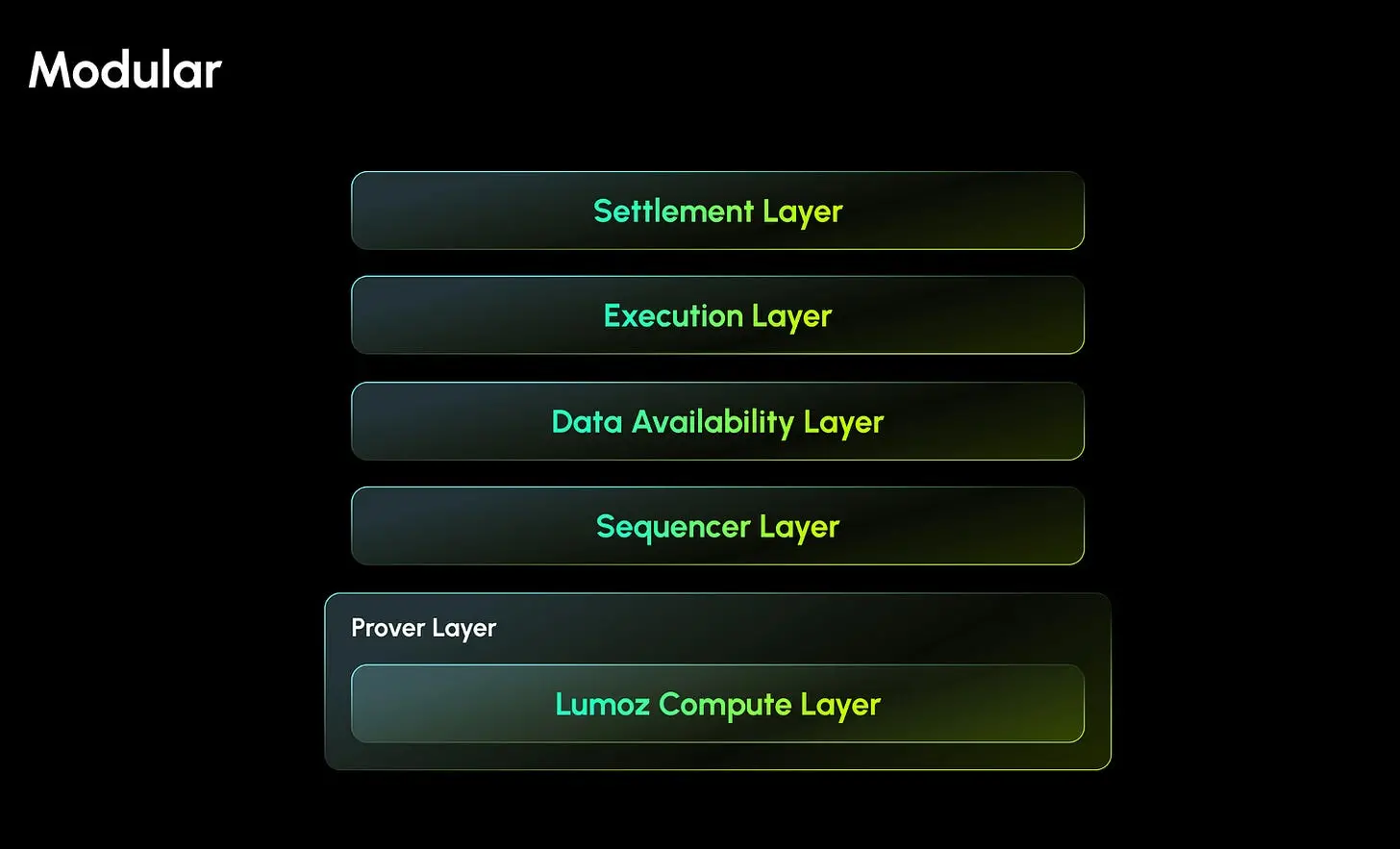
Source: Lumoz
Lumoz's modular structure offers limitless applications. For instance, it can serve as a proof layer to generate proofs for key ZK-Rollups like Polygon zkEVM, zkSync, and Scroll. It can also function as a computing layer for AI model training and inference. This design ensures flexibility and supports the integration of new technologies and services.
3.1.2. Hybrid Consensus Mechanism
Lumoz employs a hybrid architecture to manage the generation and verification of ZKP, centered around two components: zkProver for generating ZKP and zkVerifier for verifying ZKP.
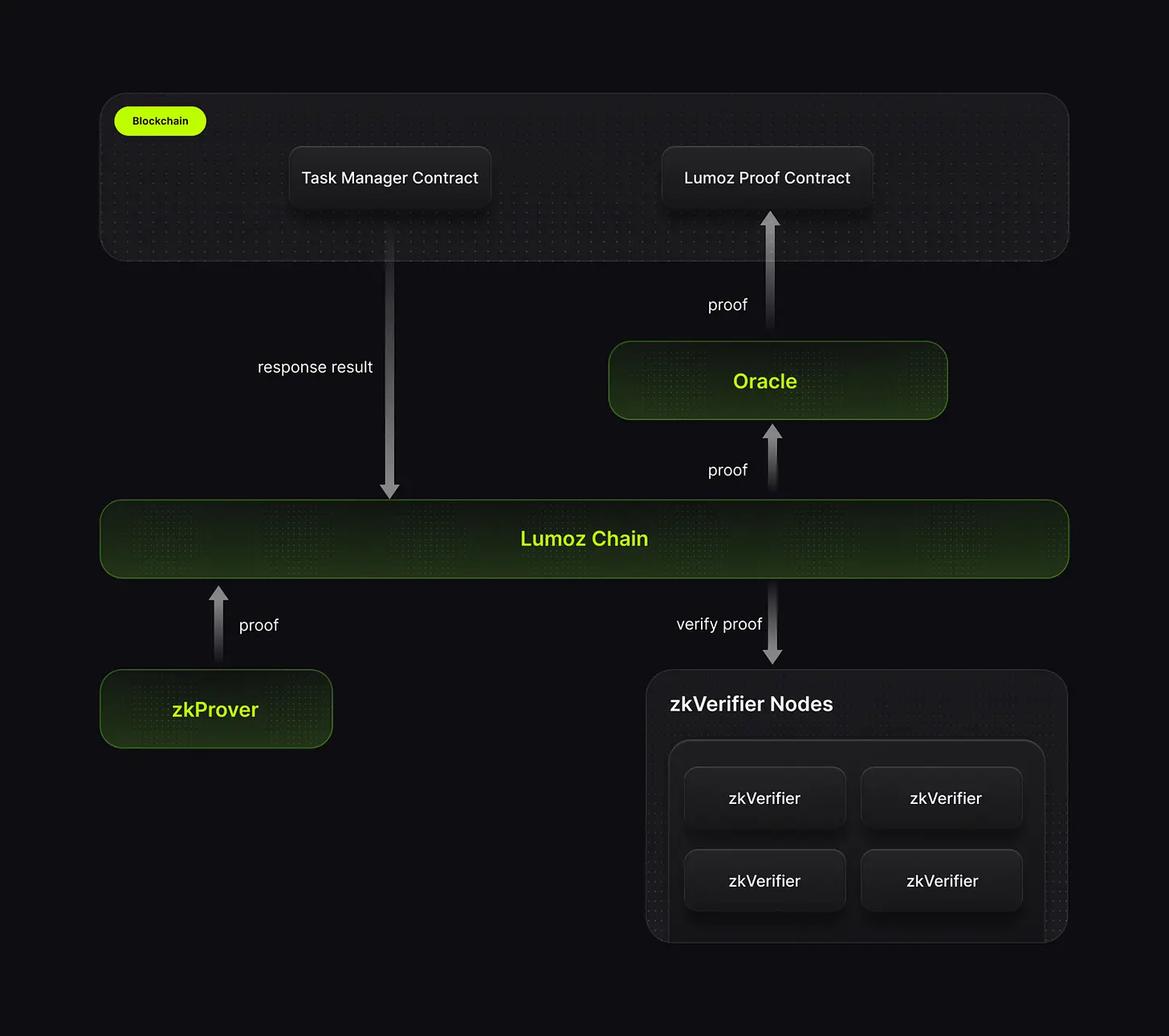
Source: Lumoz
zkProver utilizes a Proof of Work (PoW) consensus structure, as generating ZKP requires high-performance computing. Any individual or organization with GPU/CPU resources can join, leveraging their computing power to generate ZKP and perform other tasks.
zkVerifier is based on a Proof of Stake (PoS) verification network. It consists of 100,000 zkVerifier nodes issued through the sale of node licenses. License holders can run these nodes as dedicated clients or delegate them to others. zkVerifier ensures the network's credibility by verifying the proofs generated by zkProver.
This hybrid structure employs consensus mechanisms suitable for each component's role. PoW handles the high-performance computing required for ZKP generation, while PoS manages verification tasks. This approach reduces reliance on centralized high-performance devices, ensuring efficient verification through a distributed prover network. Thus, both core elements of ZKP—proof generation and verification—are efficiently processed in a decentralized manner.
3.1.3. Optimized Performance
Lumoz continuously enhances performance through ongoing research and various technological advancements. Notably, it optimizes the processes of proof generation and verification.

Source: Lumoz
Lumoz improves the efficiency of ZKP generation and verification through aggregator services. This service can process multiple proofs in parallel and combine them into a single proof. Traditional methods handle each proof independently, leading to inefficiencies due to redundant computations. Lumoz eliminates this bottleneck, significantly increasing processing speed.
Additionally, Lumoz optimizes the verification process. Previously, proof required two independent steps: the prover submits a proof hash containing their identity and work information in the first step, and then submits their ZKP in the second step. Lumoz simplifies this process by merging identity, work information, and ZKP into a single contract. This improvement reduces the number of on-chain transactions by half, lowering gas costs by 50-60% and shortening verification time.
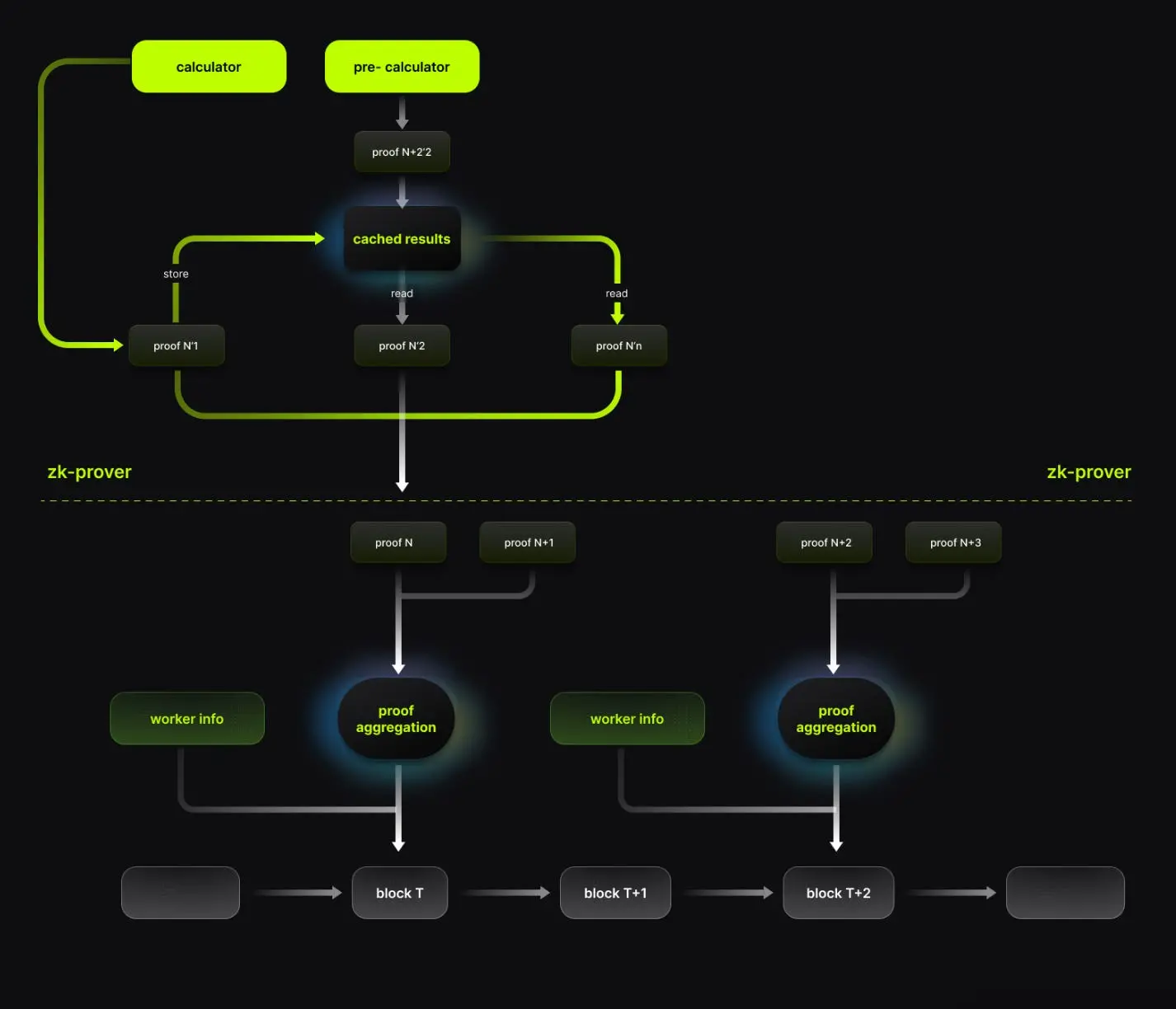
Source: Lumoz
Lumoz further optimizes the proof generation process. First, it breaks down large tasks into smaller tasks that can be processed independently. Then, when parts of different computations are the same, Lumoz saves and reuses cached results instead of recalculating. Furthermore, when computers in the network are idle, they prepare computations that may be needed soon instead of waiting for new tasks to arrive. These changes improve proof generation speed by 25% and significantly enhance cost efficiency and processing performance.
3.2. zk-RaaS Platform
Lumoz offers RaaS services to help developers build ZK-Rollup-based L2 chains without complex infrastructure. This service simplifies the process, much like how AWS simplifies cloud computing.
RaaS provides the infrastructure needed to build and operate blockchains using Rollup technology. Its intuitive interface streamlines development and operations, enhancing user convenience and efficiency.
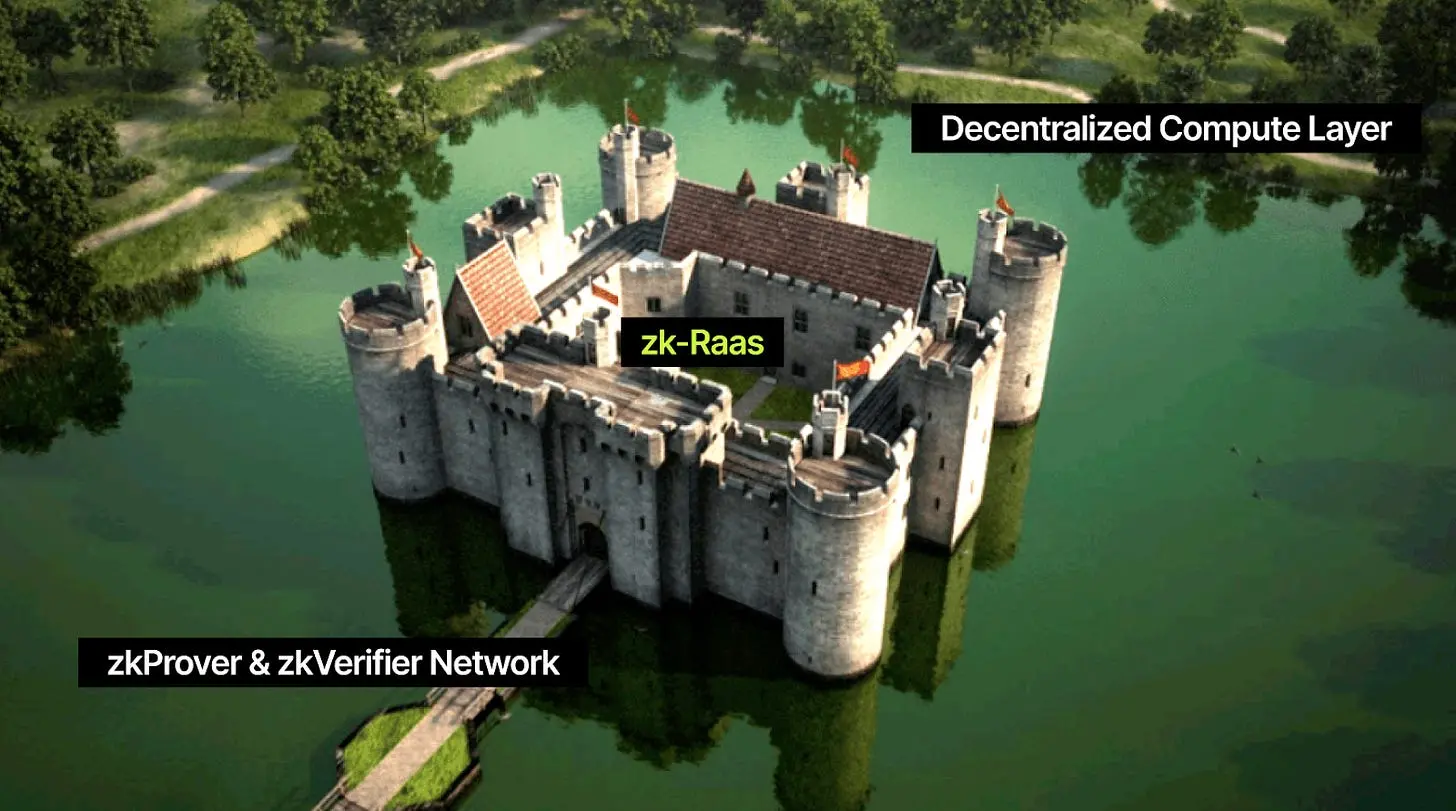
Lumoz's zk Moat & Castle, Source: Tiger Research
Lumoz's core advantage lies in its proprietary network. This network includes a decentralized computing layer, zkProver, and zkVerifier, specifically designed to handle the complex computations required for ZK-Rollups—a method for quickly processing large volumes of blockchain transactions. This capability distinguishes Lumoz from other RaaS services that lack dedicated computing networks. The decentralized computing layer serves as Lumoz's unique moat, enhancing its competitive advantage within the ecosystem.
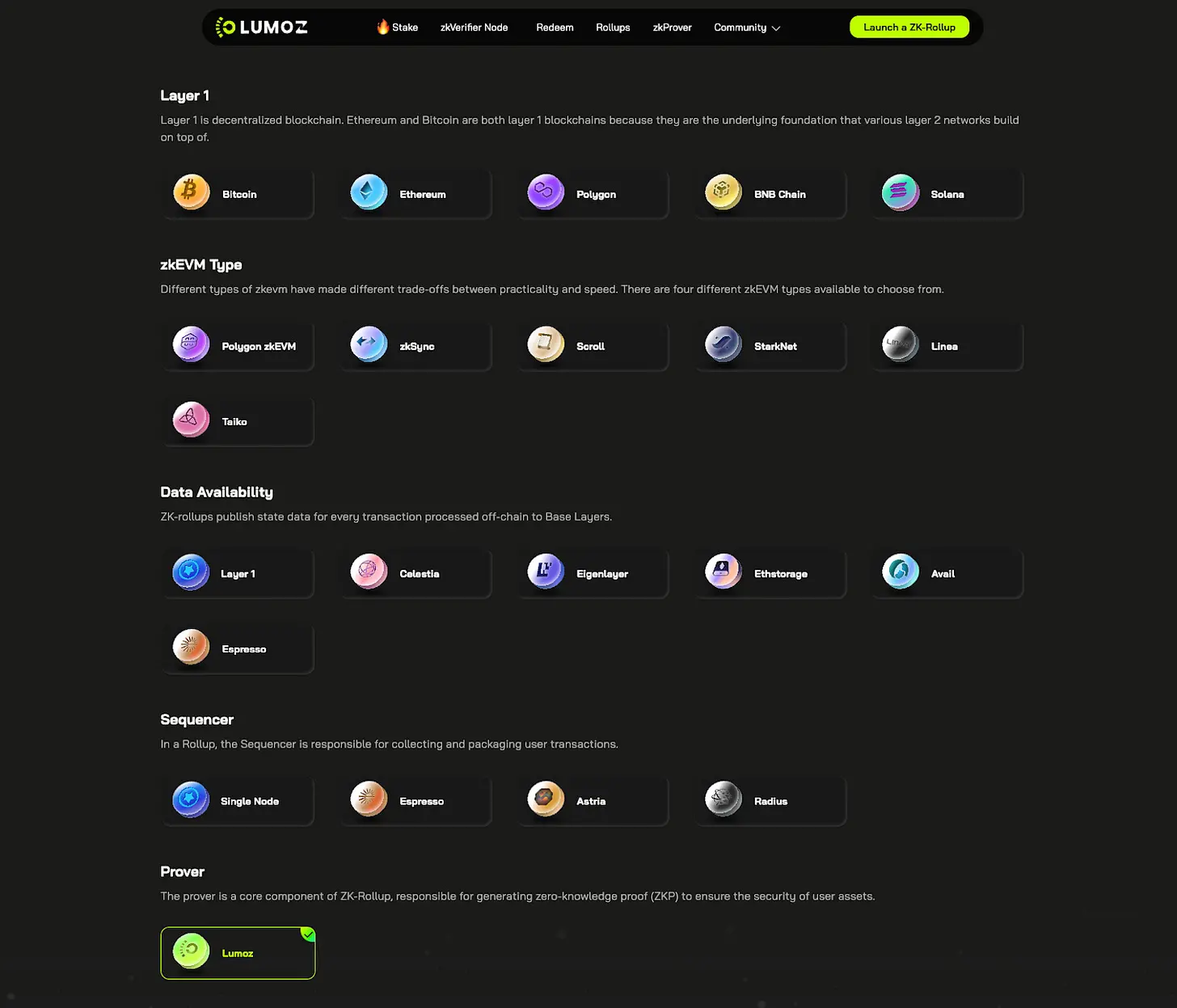
Lumoz Rollup Launchbase, Source: Lumoz
Lumoz provides an environment to connect and expand various chains and ZK-Rollups. Developers can build custom chains without dealing with complex technical setups, making system design and operation much simpler.
Lumos's Rollup Launchbase supports major blockchains such as Bitcoin, Ethereum, BNB Chain, Polygon, and Solana, as well as zkEVM types like Polygon zkEVM, zkSync, and Scroll, enabling developers to more easily build ZK-Rollup solutions.
Lumoz also supports Native Cross-Rollup Communication (NCRC), facilitating efficient encrypted transmission and interaction across Rollups. This feature utilizes Rollup System Contracts (RSC) deployed on the main chain. RSC tracks information and updates between different Rollups, enabling fast and secure transmission and interaction while ensuring the safety of all assets.
By the first half of 2025, Lumoz plans to support major L1 chains and will support EVM-based ZK-Rollups, including Solana Virtual Machine (SVM) and Ton Virtual Machine (TVM). This expansion meets the growing demand for ZK technology, strengthening Lumoz's position as a leading provider of ZK infrastructure.
4. Lumoz's Vision for the Future
Lumoz's distributed computing network can efficiently handle complex computations while meeting the growing demand without compromising reliability. While it currently focuses on zero-knowledge proofs, this powerful infrastructure can assist in developing other advanced technologies in the future.
4.1. ETH 3.0: Making Ethereum Great Again
The vision for Ethereum 3.0 is to enhance the network's scalability, security, and efficiency through Snarkification and Beam Chain. Snarkification accelerates transaction processing and improves data security by introducing ZKP technology into Ethereum's consensus and execution layers.
To achieve this, strong computational resources are needed. Lumoz provides this through its modular computing layer. It employs a hybrid consensus mechanism combining PoW and PoS. PoW provides computational power for ZKP generation, while PoS handles verification tasks. This setup achieves high-performance computing in a decentralized manner.
This infrastructure helps Lumoz optimize validators and accelerate block generation speed, which is a primary goal of BeamChain. The network can improve processing efficiency while maintaining decentralization. By supporting these improvements, Lumoz plays a crucial role in helping Ethereum grow and advance.
4.2. Building Computing Infrastructure for the AI Era
Lumoz will become a key infrastructure driving the development of AI technology. Currently, most AI systems are controlled by large tech companies. Lumoz's distributed computing network aims to make AI more accessible to everyone and change this status quo. This can help create an AI ecosystem that:
- Gives users more control
- Makes AI technology easier and cheaper to access
- Operates in a fairer and more transparent manner
This approach could foster a new type of AI system that is not controlled by a few companies.
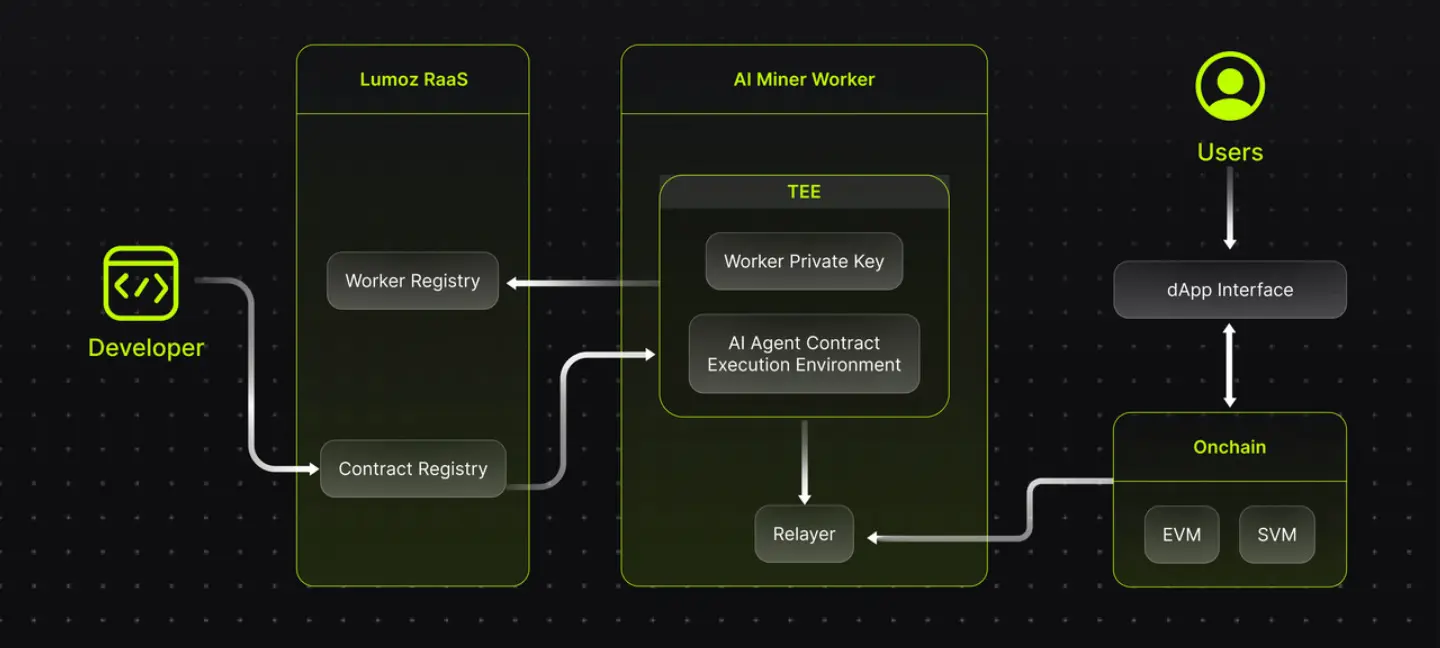
Source: Lumoz
Lumoz employs two technologies to make AI systems more secure and reliable: Distributed Remote Operations Technology (DROT) and Trusted Execution Environments (TEE). AI agents can act autonomously, but most currently operate in untrusted environments, limiting their security and transparency. In these environments, protecting sensitive information and verifying results is challenging, undermining the reliability of decision-making.
The DROT system keeps important security keys in hardware and uses a verification process called remote attestation to ensure everything operates as expected. This enhances data security and execution integrity while improving result verifiability. With these security measures, AI agents can work more safely and reliably. This combines the best features of Web3 and AI technologies, contributing to the creation of next-generation AI systems that are both secure and transparent.
5. Conclusion
Lumoz has made significant progress, with its test network attracting over 3 million users and supporting more than 50 major ecosystem projects. The platform serves over 20 Layer 2 chains and continues to expand its ecosystem through partnerships with UXLINK, CARV, Merlin Chain, Matr1x, Ultiverse, ZKFair, and others.
Lumoz does not rest on its current achievements but addresses a core challenge in Web3. By adopting zero-knowledge proof technology and distributed computing, it enhances the speed and transparency of blockchain networks. The integration with artificial intelligence creates new opportunities for future growth. This approach adheres to the fundamental principles of distributed control in Web3 while demonstrating how to combine zero-knowledge proof technology with AI to drive the development of the entire ecosystem.
As new technologies like Ethereum's BeamChain increase the demand for computational power, the need for processing capacity is expected to rise significantly. This growth may resemble the early demand for computer performance driven by Bitcoin and Ethereum mining. Lumoz has the potential to become an essential part of blockchain and AI development by providing the necessary infrastructure to meet these growing computational demands.
Furthermore, Lumoz supports various technological environments, including Trusted Execution Environments (TEE) and Fully Homomorphic Encryption (FHE). These tools lay a more solid foundation for the future development of blockchain and AI. Given how Lumoz integrates these capabilities with other technologies, its growth potential and impact on the industry will be closely watched.
Original link: https://reports.tiger-research.com/p/lumoz-acc-eng










